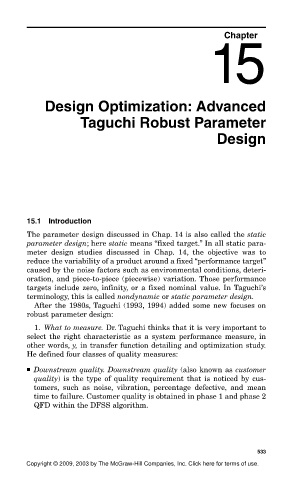Page 575 - Design for Six Sigma a Roadmap for Product Development
P. 575
Chapter
15
Design Optimization: Advanced
Taguchi Robust Parameter
Design
15.1 Introduction
The parameter design discussed in Chap. 14 is also called the static
parameter design; here static means “fixed target.” In all static para-
meter design studies discussed in Chap. 14, the objective was to
reduce the variability of a product around a fixed “performance target”
caused by the noise factors such as environmental conditions, deteri-
oration, and piece-to-piece (piecewise) variation. Those performance
targets include zero, infinity, or a fixed nominal value. In Taguchi’s
terminology, this is called nondynamic or static parameter design.
After the 1980s, Taguchi (1993, 1994) added some new focuses on
robust parameter design:
1. What to measure. Dr. Taguchi thinks that it is very important to
select the right characteristic as a system performance measure, in
other words, y, in transfer function detailing and optimization study.
He defined four classes of quality measures:
■ Downstream quality. Downstream quality (also known as customer
quality) is the type of quality requirement that is noticed by cus-
tomers, such as noise, vibration, percentage defective, and mean
time to failure. Customer quality is obtained in phase 1 and phase 2
QFD within the DFSS algorithm.
533
Copyright © 2009, 2003 by The McGraw-Hill Companies, Inc. Click here for terms of use.

